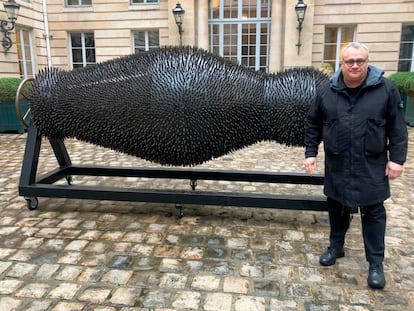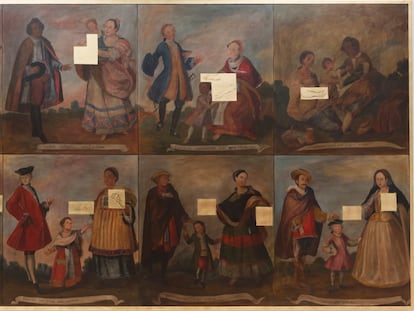The doors open for Los Angeles Art Week
The Felix and Frieze art fairs headline the cultural offerings in a city where the number of galleries has multiplied in recent years


Narrow stairs lead up to the second floor of Keith Rivers’s residence in a posh, hilly area of Beverly Hills. The first thing you see when you arrive is a large brick wall in various shades of gray. The blocks are drawn on two thick sheets of paper. They form a perfect order, rare in real-life partitions. The work is by Tony Lewis, a Chicago-based African American artist whose creations address themes of power, race and working-class labor. He began drawing to stimulate the process at a time when he felt that he had hit a wall conceptually. Laying brick upon brick made him feel serene.
Rivers owns the drawing and found in it an echo of his past life. “I love this work because it is an exercise in repetition. Doing a process over and over again to accomplish something bigger. And that was football for me. Repeating a play over and over again with a goal,” says Rivers, 37, who played at the professional level for the Cincinnati Bengals, New York Giants and Buffalo Bills.
He is a rare collector. In 2010, his first acquisition was one of the pink versions of Andy Warhol’s Electric Chair. The former athlete admits that, at the time, he thought he needed to acquire a big name to start collecting art. Over time, however, he realized that wasn’t true. He has been developing his own taste and knowledge.
The table in the center of his library reflects much of that learning process. There are books on the influential body paintings of David Hammons, one on Brazilian portraits, a monograph on Lucas Arruda and another on the art of California’s John Baldessari, a major figure in American conceptual art. There is also a worn copy of a book written by art historian Robert Farris Thompson on African American art and philosophy.
Rivers opened the doors of his home during Los Angeles Art Week. Artists, gallery owners, cultural promoters and collectors were able to view the works in his Doheny Avenue home. There are just a couple of nods to his previous occupation in his residence. The painting that presides over his living room, however, does refer to sports. Artist Cyprien Gaillard placed the enormous design of the Cleveland Indians baseball team, the caricature of Indian Chief Wahoo, over a withered, uninhabited landscape. In 2018, Cleveland retired the team name and logo in the face of fan pressure and new sensibilities.
An alumnus of the University of Southern California (USC), Rivers lent his residence to a rival school, the University of California San Diego (UCSD). One of the most important private collections of sculptural art in the United States is located there. A score of artists exhibit works throughout the public university’s 485-hectare campus in La Jolla for the enjoyment of 43,000 students. The director of the collection, Jessica Berlanga, was at the event to announce that new artists will be commissioning new works this year.
Miles down the hills, in the heart of the city, another Los Angeles institution also opened its doors to lovers of the arts. The Hollywood Roosevelt, which has tended to the luminaries of the entertainment industry for almost a century, has been hosting the Felix Art Fair since Wednesday. Created by collector Dean Valentine and gallerists Al and Mills Moran, the fair brings together galleries from around the world, which have a tiny room on the hotel’s first floor to exhibit their works.
Visitors tour those rooms. On Wednesday, hundreds of people were going in and out of the small rooms. Furniture had been removed to make room for paintings and sculptures. The works could even be seen in the bathrooms, a space that is almost always reserved for works of lesser value in homes. Here, that rule doesn’t apply.
The Felix tour also includes the legendary Tropicana pool, a work of art in itself. Legend has it that English artist David Hockney arrived at the hotel one day in 1988 to paint the bottom of the pool. With the help of a broomstick with a brush on the end, he painted hundreds of navy blue strokes. The movement of the water created a mesmerizing visual effect. This past week, the pool served as a meeting spot for dozens of attendees at an art fair with a more informal atmosphere.
In its sixth year, the Felix fair is trying to distinguish itself from the Frieze, the arrival of which is the city’s most important event of the year. Felix organizers claim that it is not a sales-driven event. Galleries from Greece to Romania to New York pay between $10,000 and $20,000 to be there. That’s just a fraction of the nearly $80,000 that the Frieze can earn for an 860-square-foot space.
The Frieze, however, continues to show its ability to draw audiences and its economic importance. On Thursday, a day dedicated exclusively to collectors and VIP guests, the fair reported the sale of a Richard Serra drawing for $2 million at Gladstone Gallery. In addition to cashing in just hours after opening its doors, the event was attended by Leonardo DiCaprio and Robert Downey Jr., who made time to appreciate some art in the midst of his Oscar campaign. These are signs of the robust market in Los Angeles.
Sign up for our weekly newsletter to get more English-language news coverage from EL PAÍS USA Edition
Tu suscripción se está usando en otro dispositivo
¿Quieres añadir otro usuario a tu suscripción?
Si continúas leyendo en este dispositivo, no se podrá leer en el otro.
FlechaTu suscripción se está usando en otro dispositivo y solo puedes acceder a EL PAÍS desde un dispositivo a la vez.
Si quieres compartir tu cuenta, cambia tu suscripción a la modalidad Premium, así podrás añadir otro usuario. Cada uno accederá con su propia cuenta de email, lo que os permitirá personalizar vuestra experiencia en EL PAÍS.
¿Tienes una suscripción de empresa? Accede aquí para contratar más cuentas.
En el caso de no saber quién está usando tu cuenta, te recomendamos cambiar tu contraseña aquí.
Si decides continuar compartiendo tu cuenta, este mensaje se mostrará en tu dispositivo y en el de la otra persona que está usando tu cuenta de forma indefinida, afectando a tu experiencia de lectura. Puedes consultar aquí los términos y condiciones de la suscripción digital.
More information
Archived In
Últimas noticias
There is as much life left to discover on planet Earth as that which is already known
Dozens presumed dead, around 100 injured in fire at Swiss Alps bar during New Year’s celebration
Is porn for women different from conventional porn? We spoke to those who make it
Cartagena de Indias is sinking: What can the city do to mitigate it?
Most viewed
- David King, chemist: ‘There are scientists studying how to cool the planet; nobody should stop these experiments from happening’
- Reinhard Genzel, Nobel laureate in physics: ‘One-minute videos will never give you the truth’
- Oona Chaplin: ‘I told James Cameron that I was living in a treehouse and starting a permaculture project with a friend’
- Sinaloa Cartel war is taking its toll on Los Chapitos
- The Interoceanic Train, the Mexican alternative to the Panama Canal










































